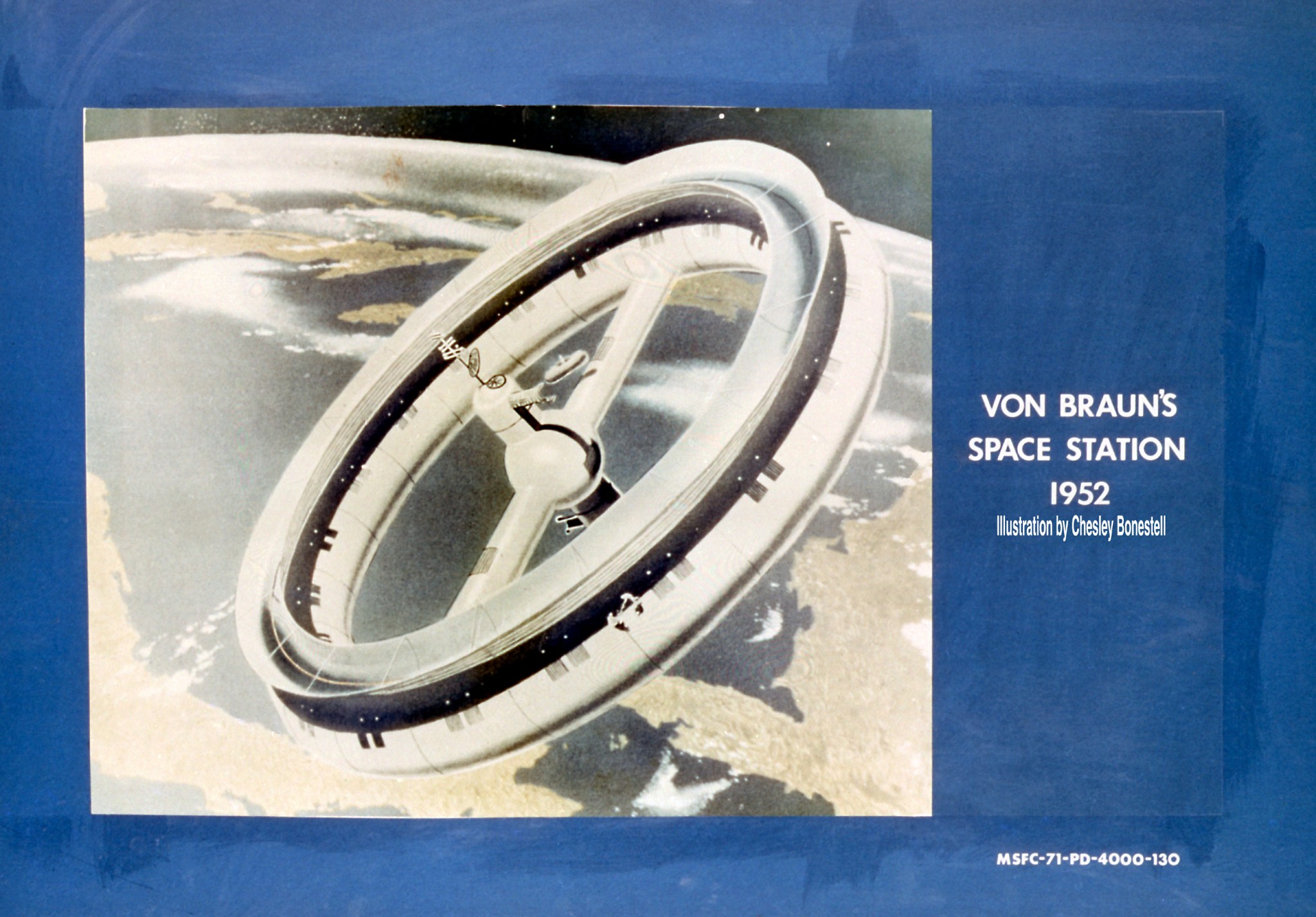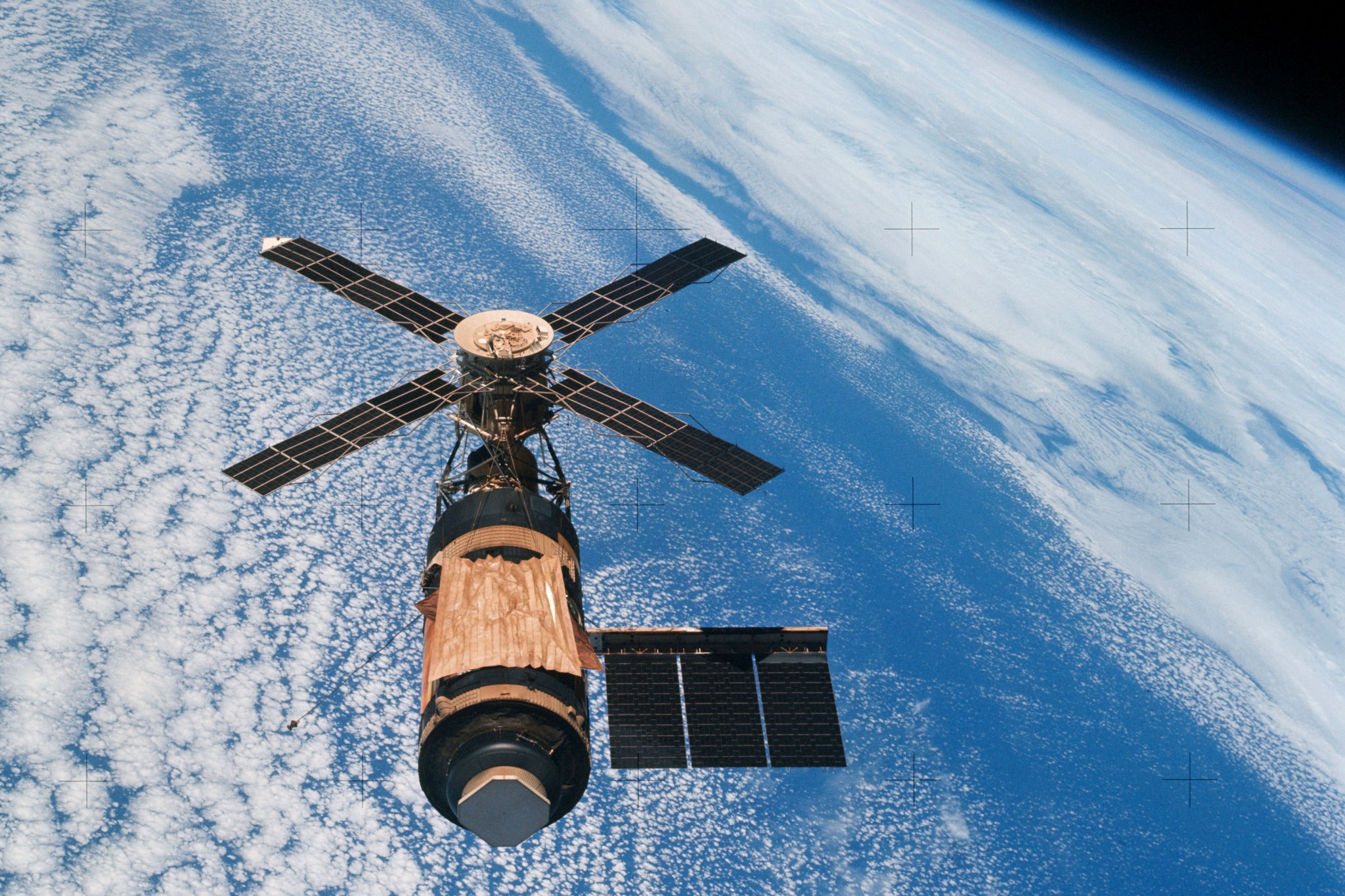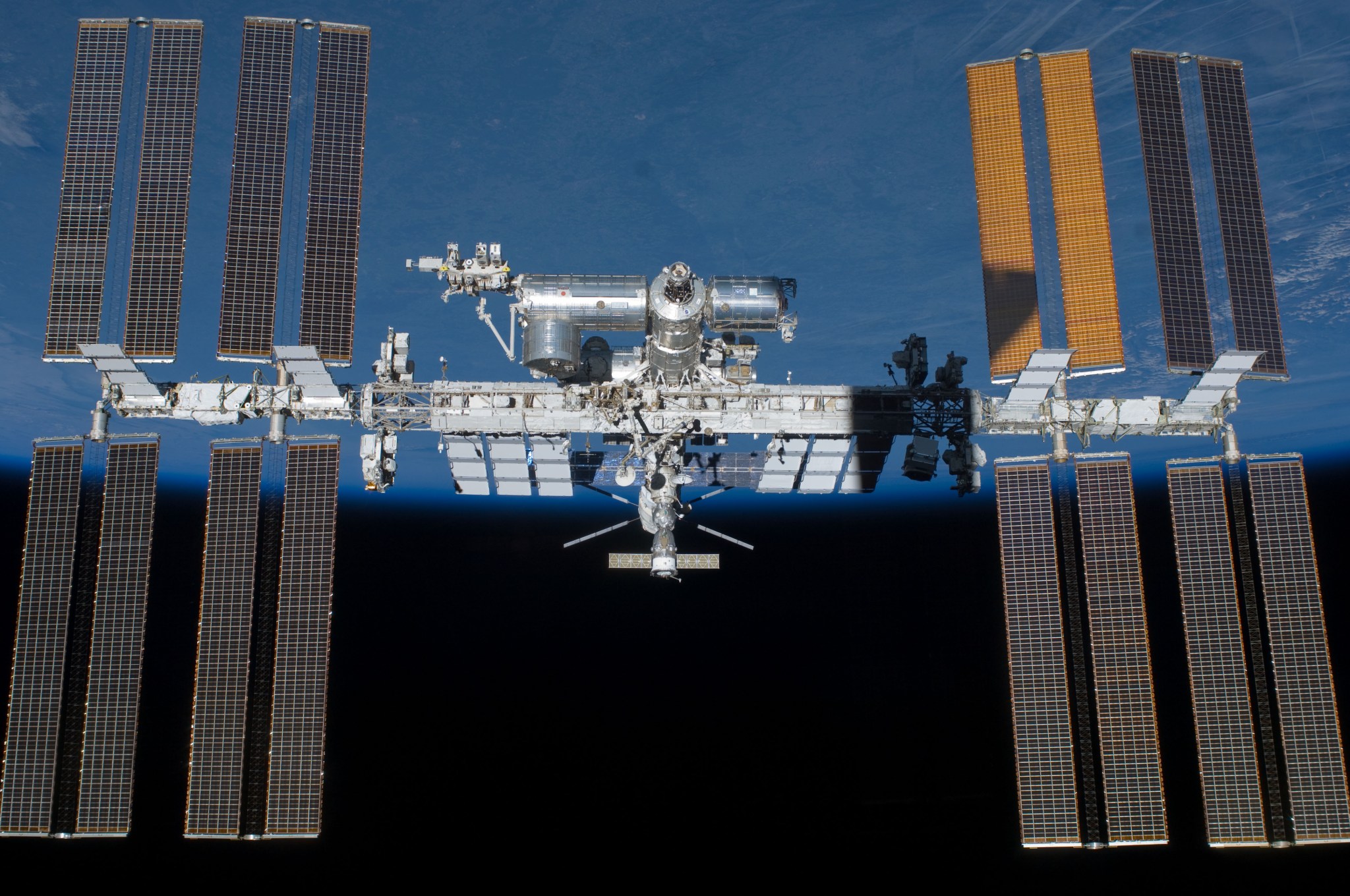View Related Space Stations Imagery
From Dream to Reality: Marshall Space Flight Center’ Role in Developing Space Stations
By Tracy McMahan
Many people at NASA’s Marshall Space Flight Center in Huntsville, Alabama, support International Space Station operations. While today’s space station is vastly different than the Cold War station imagined by early rocket pioneers, in many ways, it still fulfills some of the main missions that they envisioned:
- conducting research that can serve as a springboard for exploration and benefit people on Earth,
- helping people learn to live in the hostile environment of space, and
- promoting peace in the world.
In early 1952, years before NASA was even a twinkle in President Dwight Eisenhower’s eye, Dr. Wernher von Braun, who in 1960 became the Marshall Center’s first director, wrote about his dreams in Collier’s magazine: “Development of the space station is as inevitable as the rising of the sun; man has already poked his nose into space and he is not likely to pull it back.”[1]
Von Braun described a majestic, 250-foot-wide wheel that would orbit 1,075 miles above Earth and rotate to provide artificial gravity. Von Braun’s ideas and an artist concept by Chesley Bonestell inspired the station in the movie 2001: A Space Odyssey.[2] In von Braun’s grand scheme, a station would have been built before human voyages to the moon– a plan he outlined in a subsequent Collier’s article. He described the station as “the ever-watchful guardian of the peace” and continued on to say, “the station will provide the springboard for one of the greatest scientific advances in history: the lunar journey men have dreamed of for centuries.” His station of the 1950s resembled a combination fortress and research lab capable of housing eighty men. He and other experts featured in Collier’s predicted the station could be built by 1967 for a cost of $4 billion (in 1952 dollars) and called it “the next long step in space,” to be followed by lunar missions by 1977.[3]
Skylab: Turning A Rocket Into A Space Station
Plans changed. The U.S. wanted to beat the Soviet Union to the moon, and President John F. Kennedy set a goal to get to the moon before the end of the 1960s. Von Braun put his ideas for a space station on hold and focused on leading teams at the Marshall Center as they worked with industry to build the Saturn rockets that sent men to the moon. Even as the U.S. raced to the moon, Marshall engineers–inspired by von Braun’s ideas and NASA Associate Administrator George E. Mueller’s desire to look beyond the Apollo moon missions–continued to study space stations through what became the Apollo Applications Program. As early as 1962, Marshall engineers proposed concepts to outfit refurbished Saturn rocket stages that were readily available in NASA’s inventory. Some concepts involved connecting clusters of spent rocket stages to form a large station that could be gradually expanded.[4] This led to a precursor of today’s International Space Station: Skylab, a two-level workshop made from a converted Saturn V, S-IVB stage. Skylab– the first American space program wholly dedicated to scientific research–was staffed by three crews who performed hundreds of experiments for more than 171 days from May 1973 to February 1974.
Skylab, still a product of the U.S. Cold War strategy, was an economical way for the U.S. to compete with the Soviet Union, which by the early 1970s had abandoned its quest to send humans to the moon and was already operating a small station in space. Von Braun’s large wheel station would have been constructed by hauling “prefabricated” parts to space and assembling the station in orbit, in much the same way the International Space Station was constructed from 1998 to 2011.[5] As budget pressures mounted in the late 1960s and early 1970s, NASA, along with the team at Marshall determined the most affordable way to build Skylab was the “dry workshop” concept, which involved assembling Skylab on the ground and outfitting the orbital outpost on Earth with everything needed for survival and research in space. This included food, film, and other perishable items. The Apollo capsule did transport limited cargo to Skylab when each crew arrived.[6]
NASA selected this approach because of dwindling budgets for space exploration. Spending on the Vietnam War and increased spending on Great Society programs meant America would spend fewer federal dollars on space. Throughout President Lyndon B. Johnson and President Richard Nixon’s administrations, NASA’s future direction after Apollo including the plans for the Skylab workshop waxed and waned.[7] As early as 1968, the U.S. had already slowed down production of the Saturn vehicle, and NASA leadership was examining the next steps for human spaceflight, which were outlined in a 1969 plan.[8] Von Braun presented a roadmap to Nixon’s Space Task Force chaired by Vice President Spiro T. Agnew.[9] President Nixon made it clear that he would not approve von Braun’s plans that included a large space station, a space shuttle for traveling between the Earth, the station, and the moon, more lunar voyages, and eventual trips to Mars by no later than the end of the 20th century.[10] President Nixon and Congress only authorized funding for proceeding with Skylab and new funding for the space shuttle.
NASA ditched the name Apollo Applications Program and adopted the name Skylab in February 1970. Activity ramped up at Marshall as it began working with a contractor to outfit the orbital outpost and build equipment for experiments.[11] The entire lab and all its equipment launched to space a little more than 40 years ago on May 14, 1973, aboard the last Saturn V rocket ever to travel in space. Skylab got off to a bumpy start.
Almost immediately, the team learned a lesson in real-time operations and working outside in the harsh space environment. During the launch, Skylab’s sunshield/micrometeoroid shield was ripped away and one of its solar arrays was damaged. Without the sunshield, temperatures inside the lab were too hot for human occupation and food and other items were destined to perish. Teams from Marshall and NASA Johnson Space Center in Houston, which was responsible for Skylab operations, had to come up with repair before astronauts could be sent to the lab. The team developed a temporary repair, and the first Skylab crew used Marshall’s underwater Neutral Buoyancy Simulator to practice the repair procedures. Ten days later, the first Skylab crew traveled to the lab and undertook what at the time was the most complicated repair ever attempted during an extravehicular activity. They installed a temporary sunshield and removed the damaged solar array. Crews on the ground and in space learned about the complications of working outside the spacecraft. The successful repair enabled the Skylab science missions to get underway.[12]
Skylab experiments in almost every scientific discipline confirmed von Braun’s predictions about space research by providing the foundations for understanding how humans could live in space for extended periods. Skylab also disproved some of von Braun’s early notions. It showed humans would not need artificial gravity included in von Braun’s early space station concept. Skylab experiments revealed microgravity was not only beneficial but also even necessary for some research. NASA has learned that humans can live in microgravity and that microgravity is itself a key area of scientific activity with benefits in the form of improved products and processes back on Earth and even in uncovering physics and physical phenomena that cannot be seen on Earth. In low gravity, fires burn different, cellular processes are transformed, and physical processes, especially those involving fluids, operate differently.
Spacelab: Turning The Space Shuttle Into a Science Laboratory
The Marshalls Center engineers used their experience developing hardware and experiments for Skylab on Spacelab–the reusable laboratory flown inside the Space Shuttle from 1983 to 1998. Marshall managed the Spacelab Program, which lasted 17 years, flew 36 missions flown both on external pallets and in pressurized modules, and completed 800 investigations. According to a NASA report, “Spacelab was not only a precursor to the International Space Station, but also played a role in collaborative research with Russia’s space station Mir.”[13]
Marshall developed a multiple-user rack system, which was tested aboard Spacelab and now houses experiments inside the space station. Real-time, around-the-clock science operations were pioneered during Spacelab missions from the payload operations center at Marshall. Perhaps, most importantly, Spacelab established another precedent: it became the first program that included broad participation with international partners. In 1973, NASA and ESA signed a Memorandum of Understanding creating Spacelab and signaling a time of cooperation rather than competitiveness as the preferred mode for space exploration. The European Space Agency built the Spacelab module and other equipment in exchange for flying experiments and European astronauts in space. Japanese and German space agencies sponsored entire dedicated research missions. This shifted the paradigm from one of the U.S. conquering space to one in which the U.S. led an international coalition conducting space missions. Along the way, Marshall pioneered managing a program with hardware built in multiple places around the globe and with investigations conceived by an international community of researchers.[14]
International Space Station: A Global Orbital Lab and Engineering Feat
As NASA and the world used Spacelab to learn how to conduct science in orbit and to identify the most pertinent research questions to be explored on longer missions, Marshall engineers continued to contribute to the agency’s plans for a larger station, more like the one von Braun had envisioned. Fifteen years ago in December 1998 when the first U.S.-built element–the Unity node–of the International Space Station was placed in orbit, the dream of a large orbiting lab began to take shape. The International Space Station supports a crew of up to seven, has an internal, pressurized living and working space about the size of a five-bedroom house, and externally is about the size of a football field. It is not a wheel-shaped space station, nor an all-American space fortress that some in the Cold War era imagined. Today’s International Space Station was built not by one nation but by 15 nations, including Russia, working together on the largest, peacetime, multinational program ever attempted.
Unity, along with the U.S. Destiny laboratory, the Quest air lock, and experiment racks and facilities were built by The Boeing Company in the same Marshall facilities where the Saturn V was first manufactured. Another Saturn V-era building houses the Marshall team that keeps the station’s life support system up and running. This team designed the station’s environmental control and life support system that provides clean air and water, and some are now working on life support systems that could be used for habitats on Mars or other locations. Some parts of the life support system were used to develop a portable system for providing clean water during disasters on Earth.
Marshall’s role in payload operations began during Spacelab continues today on the space station. In 2001, with the delivery of the Destiny laboratory, Marshall began staffing the Payload Operations Integration Center, the command post for space station science, 24/7, every day of the year. The Marshall team works with the mission control team at the Johnson Center to conduct all the science operations on the station. Astronaut crews finished the assembly of the space station in the fall of 2011, and since then Marshall has played a major role as crew science operations have accelerated on the space station. Even while the crew sleeps, the ground team, which works around-the-clock, is operating experiments and getting data to investigators. New investigations are added during each six-month station expedition. The International Space Station Program Science Office at the Johnson Center has documented numerous benefits from using technologies from the Canadian robotic arm for brain surgery to understanding combustion in space and in rocket engines to developing vaccines and discovering why some cells become cancerous.[15]
Today, the citizens of Earth can gaze into the night sky and see the International Space Station, an unprecedented scientific, technological feat built through cooperation of many countries. As von Braun wrote in Collier’s more than sixty years ago, “If we do it (build a space station), we can not only preserve the peace but we can take a long step toward uniting mankind.”[16] Marshall’s first center director may have not been right about all the technical details, but he was right about the station’s important role as a peaceful, cooperative endeavor, about its ability to serve as a springboard for exploration, and about its place in preparing humans to live and work in space. The International Space Station is visible proof of humankind’s commitment to peaceful exploration of the universe.
[1] Wernher von Braun, “Crossing The Last Frontier,” Colliers, March 22, 1952: 26.
[2] Von Braun, “Crossing The Last Frontier,” 25.
[3] Wernher von Braun, “Man on the Moon,” Colliers, October 18, 1952, 51.
[4] David Compton and Charles D. Benson, “From Spent Stage to Orbital Cluster, 1965-1966,” Living and Working in Space, A History of Skylab, NASA SP-4208, 1983: 22-39.
[5] Wernher von Braun, “Man on the Moon,” 51.
[6] Compton and Benson, 22-39.
[7] Compton, Benson,106-112.
[8] An Integrated Program of Space Utilization and Exploration for the Decade 1970 to 1980, NASA Technical Memorandum, NASA-TM-74851. July 16, 1969.
[9] Wernher von Braun, Manned Mars Landing, Presentation to the Space Task Group, August. 4,1969.
[10] Mark O. Hatfield, Senate Historical Office, “Spiro Theodore Agnew (1969-1973),” Vice Presidents of the United States, 1789-1993 (Washington, U.S. Government Printing Office, 1997), www.senate.gov: 481-488.
[11] Compton and Benson, 114-115.
[12] Compton and Benson, 253-276.
[13] “The Spacelab Accomplishments Forum,” Edited by J. Emond, Proceedings from a Forum held at NASA Headquarters, Washington, D.C. March 10-11, 1999, NASA-CP-2000-210332, June 2000: 1.
[14] Schumacher, John. “Spacelab’s Role in Fostering a Global Community,” The Spacelab Accomplishments Forum,” Edited by J. Emond, Proceedings from a Forum held at NASA Headquarters, Washington, D.C., March 10-11, 1999, NASA-CP-2000-210332, June 2000: 11-16.
[15] Julie Robinson, International Space Station Benefits for Humanity,” NASA Johnson Space Center, NASA NP-2012-02-003, February 2012 (www.nasa.gov/mission_pages/station/research/benefits/index.html).
[16] Wernher von Braun, “Crossing The Last Frontier,” Colliers, March 22, 1952: 25.






























